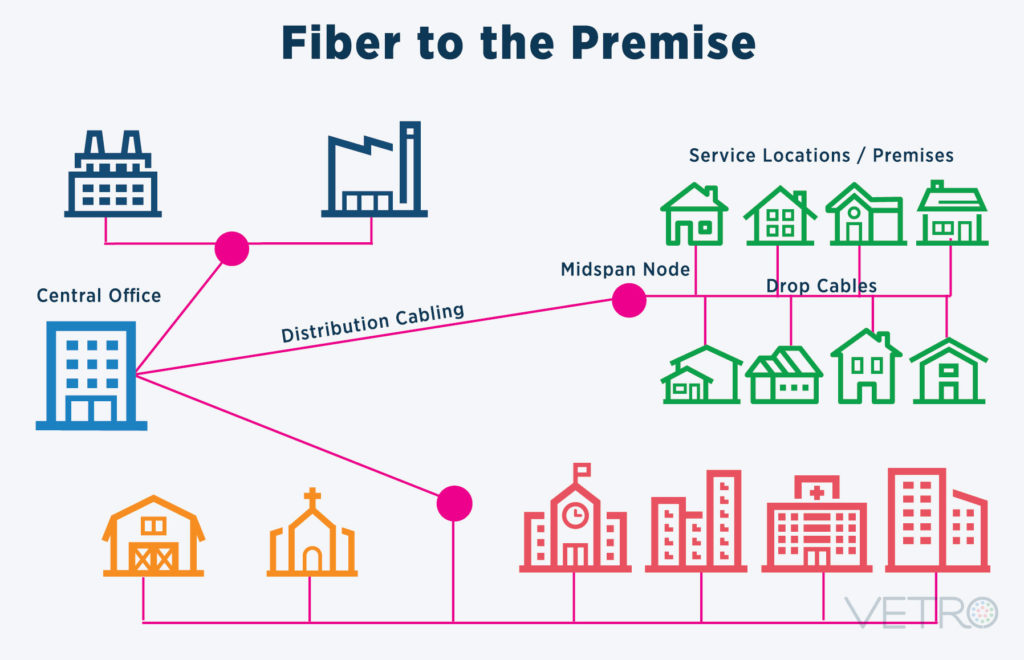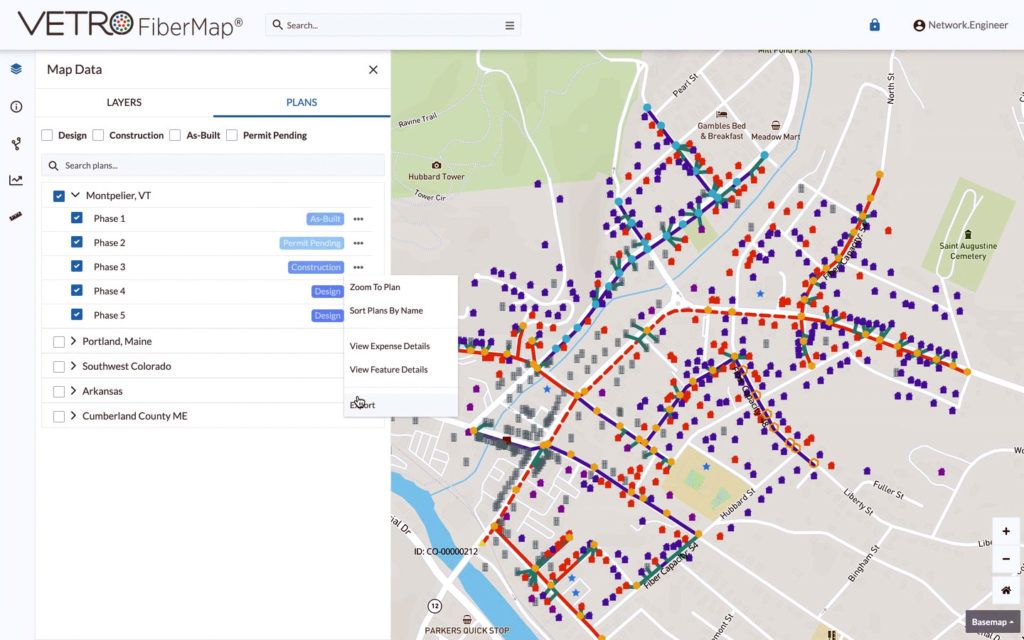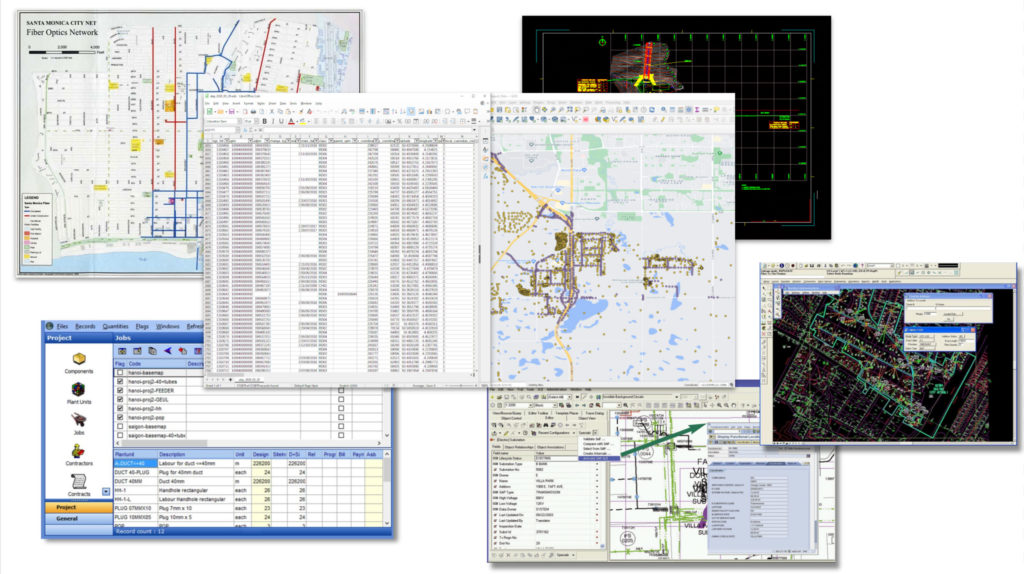What is OSP?
In telecom, OSP stands for outside plant. Put simply, OSP refers to all of the equipment, cables and infrastructure that are located outside of a building. While the term outside plant can be used when referring to communications networks like telephone or cable, today we’ll dive into OSP fiber networks, the foundation upon which the internet is built.
But first, let’s do a quick overview of the general anatomy of a fiber to the premise, or FTTP, network so that we can see where OSP fits in.

Anatomy of FTTP
Fiber to the premise describes a fiber optic network that connects homes, businesses or any building (the “premise,” or service location) to high speed broadband service. An example of a widely recognized brand name in FTTP networks is Verizon Fios, but FTTP is offered globally by internet operators of every size and shape. As broadband funding heats up in the US and beyond, rural electric cooperatives, utility companies, school districts and an almost unlimited variety of other institutions are becoming ISPs, entering the fiber space to offer fiber to the home, business and beyond.
Every fiber to the home network is unique, making generalizations about fiber to the home network design difficult. To define OSP, the description of network design offered here will be a simplified example of only one type of possible fiber to the home design.
The Central Office
A fiber to the premise network starts at the central office, or CO, also referred to as a headend, point of presence (PoP) or data center. The CO is the start of a fiber to the premise network – picture a big server room with lots of wires and equipment, the “brain” of the operation. The network begins here, pushing an optical light signal out to other locations via distribution cables.
Distribution
Distribution cabling is a dense bundle of fiber cables designed to carry large amounts of data between two locations on the same network. The Fiber Optic Association offers a thorough deep dive into fiber cables on their web site if you’re curious about the details of fiber cabling.
In this example, the first location the distribution cables will connect is the central office. The distribution cables will physically connect to one or more locations outside of the central office. This second location or locations are called midspan nodes. These nodes are typically close to a neighborhood, business center or other area identified to receive service from the ISP operating the network.
The Midspan Node(s)
The Midspan node is a physical location on a network, at which network equipment is housed in a case, cabinet, manhole or other “container.”
There is a wide variety of equipment that might be placed at a midspan node, but the notable equipment in this example is a splitter. The splitter will further distribute the optical light signal downstream to the service location.
The Premise / Service Location
From the midspan node, the network must carry the light signal to and from each individual home, business or other type of premise on the network. The main cables that leave the midspan node to travel to a street or group of premises in a neighborhood are called drop cables.
The point on the outside of the building where the drop cable connects is often called an optical termination point.
This connection point houses equipment that will convert the optical light signal sent by a fiber strand into an electrical signal that is then distributed to users in the home via a modem. The modem then connects to an internet-enabled device via an ethernet cable or, more commonly, a wireless router that enables the connected customer to binge “Squid Game,” work from home or broadcast their Twitch stream with the fastest, most reliable connection.

The Physical Internet
If you work in OSP management, engineering or network design, you know how oversimplified the above description is. However, it provides the basis of understanding outside plant or OSP.
Outside Plant represents all of the physical cables, equipment and locations outside of a building. In the above example, outside plant starts at the point at which the distribution cabling leaves the central office, and ends at the termination point on the outside of a premise receiving internet service. All of the physical, tangible assets that enable your network between two “inside” locations make up the outside plant network.
Designing an OSP network is a highly specialized function, and getting it right can be difficult. The example used here is an abridged version of an actual fttp network and does not adequately represent the vast amount of equipment that a network uses; in addition the large inventory that must be accounted for, OSP also takes into account the relationships between equipment and cables and how things are affected downstream and upstream when any changes are made.
A Constantly Shifting Relational Landscape
Engineers designing OSP networks must also consider how they will troubleshoot the network and make repairs and upgrades. To fix something, you must be able to physically reach it. So OSP design and planning has to include careful consideration around where a piece of equipment can be located. To decide whether a splitter can be located at a certain place, for example, an engineer may have to visit the location and look for a manhole or telephone pole to put it on, or determine whether there is public land on which to place a cabinet.
As if all of these operational logistics weren’t enough, OSP engineers are also tasked with planning and maintaining capacity – how much data can flow through any one location on the cables and equipment in place. A network’s capacity can change in an instant if a storm blows a tree down onto aerial cables, a flood wipes out electrical connections to equipment, or sneaky little critters decide they want to chew through buried fiber cables. When that happens, OSP engineers are on the job to determine how to fix the network, re-route the signal, or come up with any number of other solutions. OSP professionals are the creative heroes of fiber network operations.
The Devil is in Documenting the Details
So how do OSP professionals keep all of this constantly changing data straight? It’s all about documentation. Records that are easy to access, understand and update are a critical need in managing outside plant fiber. But due to the complex relational connections between connectivity and physical assets, documentation might be the most difficult part of any OSP job.
Everyone knows how to use spreadsheets to manage data, but they’re hard to maintain and are missing that key “third dimension” of network documentation: physical location overlaid with connectivity.
Documenting the hardware, connection points and even just the fibers inside each cable are a great start. But to bring all of these dimensions to life and make the data actionable and accessible, visualizations and maps are the real answer. More than a google map with lines drawn on it to represent a network, OSP design and management require geospatial (GIS) mapping done with tools designed to represent complex data as it exists in the physical world.
Some OSP engineers use generic GIS software like QGIS to gain insight into that crucial third dimension, creating map-based representations of their networks. And for those engineers that have deep GIS expertise and the time to set up a customized set of data parameters to use in the system, these kinds of GIS platforms offer the ability to view and edit network data.

The Future of Fiber: Democratized Documentation
Here at VETRO, we’re proponents of using a purpose-built fiber OSP design, documentation and management solution. Our first look at fiber design and management was back in 2008, when VETRO was called NBT Solutions and built custom GIS platforms for all kinds of clients. ISPs asking us for the ability to design, document and manage all of their OSP information in a flexible cloud environment was how we first conceived of and started building VETRO FiberMap, our flagship fiber management platform.
More than a decade later, and with hundreds of conversations with OSP professionals fueling our product, we found that the solution to the massive and complex challenges faced by network operators was simple: build a system tailored to fiber that relieves your core OSP engineering team of the burden of meticulous documentation, endless updates, swivel chair syndrome and errors across multiple apps.
And as we rolled VETRO FiberMap out to our customers, what we saw was incredible: pristine documentation that can be engaged with easily doesn’t just prevent problems and save time. Our customers began to use their network documentation to gain new insight into their operations, optimize capacity, unearth new revenue streams and gain productivity across every department of their businesses. Great documentation isn’t just a stopgap; it creates opportunity and gives you the peace of mind you deserve.
So, what is OSP? It’s both the physical assets upon which connectivity runs and the deeply detailed documentation that gives an ISP the information it needs to offer the very best service to their customers. OSP professionals show us time and again that your network map is as valuable as your network itself.



